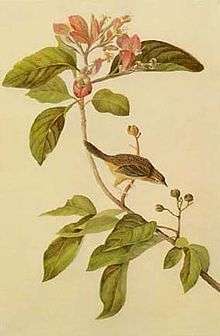Pinckneya pubens
| Pinckneya pubens | |
|---|---|
 | |
| Branch of Pinckneya pubens from The Birds of America; branch painted by Maria Martin | |
| Scientific classification | |
| Kingdom: | Plantae |
| (unranked): | Angiosperms |
| (unranked): | Eudicots |
| (unranked): | Asterids |
| Order: | Gentianales |
| Family: | Rubiaceae |
| Subfamily: | Cinchonoideae |
| Tribe: | Cinchoneae |
| Genus: | Pinckneya |
| Species: | P. pubens |
| Binomial name | |
| Pinckneya pubens Michaux | |
 | |
| Natural range of Pinckneya pubens | |
| Synonyms | |
|
Pinckneya bracteata (W. Bartr.) | |
Pinckneya pubens, the Georgia bark or fevertree, is a small tree of the southern United States closely resembling the cinchona or Peruvian bark. It has pretty, large white flowers, with longitudinal stripes of rose-color. The wood is soft and unfit for use in the arts. The inner bark is extremely bitter, and is employed with success in intermittent fevers.
Habitat and cultivation
Pinckneya is native to poorly drained acidic soils, as along swamp margins. Soils may be fine, medium or coarse textured. Good pest resistance and distinctive flower characteristics make this species of interest to gardeners, who should ensure that it receives occasional irrigation over a dry summer.[1]
References

- Edgar Herman and another (1885). "Pinckneya pubens, Michaux. (Georgia Bark.)". Henriette's Herbal Homepage. Retrieved 3 April 2013.
- "Pinckneya bracteata". Henriette's Herbal Homepage. Retrieved 3 April 2013.
This article is issued from
Wikipedia.
The text is licensed under Creative Commons - Attribution - Sharealike.
Additional terms may apply for the media files.